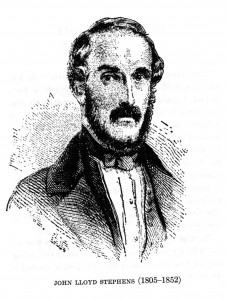Welcome to the Incidents of Travel in Yucatan blog! Let me tell you a bit about our project and my own reasons for making this journey to Mexico.
Our group is travelling in the footsteps (or as close as we can come) of John Lloyd Stephens and Frederick Catherwood. Stephens was a U.S. citizen who travelled on a “special confidential mission” from the American President to central Mexico. He invited his friend, Catherwood, an Englishman, to join him on this journey. Catherwood, an experienced traveller, had spent ten years studying and drawing Mediterranean antiquities. Together, the two travelled Central America, drew and documented Mayan ruins, and described the local communities that they passed through. We hear of the stones they saw and the people they met, especially the ones they hired to carry their baggage, prepare their meals, and provide a place to swing a hammock. We hear of the faint and narrow path they travelled, the mules, the mud, the rough scrub, the heat, and the sting of garrapatas (mosquitoes?).
This week, we are travelling similar territory, but a very different world, and in a very different manner. I come to the project as a classicist, an archaeologist and a historian. I, too, have spent many years studying ancient Mediterranean antiquities. But unlike Stephens and Catherwood, on this journey I’m a tourist, not a traveller. By comparing of our incidents of travel in the Yucatan with those of Stephens and Catherwood I hope to come to a better understanding of global tourism.
One question that interests me is what is the history of this place? Incidents of Travel in the Yucatan shows us the nineteenth-century Yucatan through American eyes. The ruins we are going to tour and Stephen’s narrative are tangled in a greater story of colonialism and its aftermath. Stephens claims a certain ownership of the ruins (indeed, he purchases one of them):
The reader is perhaps curious to know how old cities sell in Central America. Like other articles of trade, they are regulated by the quantity in market, and the demand; but not being staple articles, like cotton and indigo, they were held at fancy prices, and at that time were dull of sale. I paid fifty dollars for Copan. There was never any difficulty about the price. I offered that sum, for which Don Jose Maria thought me only a fool; if I had offered more, he would probably have considered me something worse. (Stephens, Incidents of Travel in Central America, Chiapas and Yucatan, p.128)
Who owns the past? How have Mayan remains been researched, bought, sold, reconstructed, collected, displayed, narrated, and toured? And what does this history reveal about the relationship between America and Yucatan? What does the journey of Stephens and Catherwood together with our own Incidents of Travel in the Yucatan teach us about the tangled history of this part of the world and our own?





